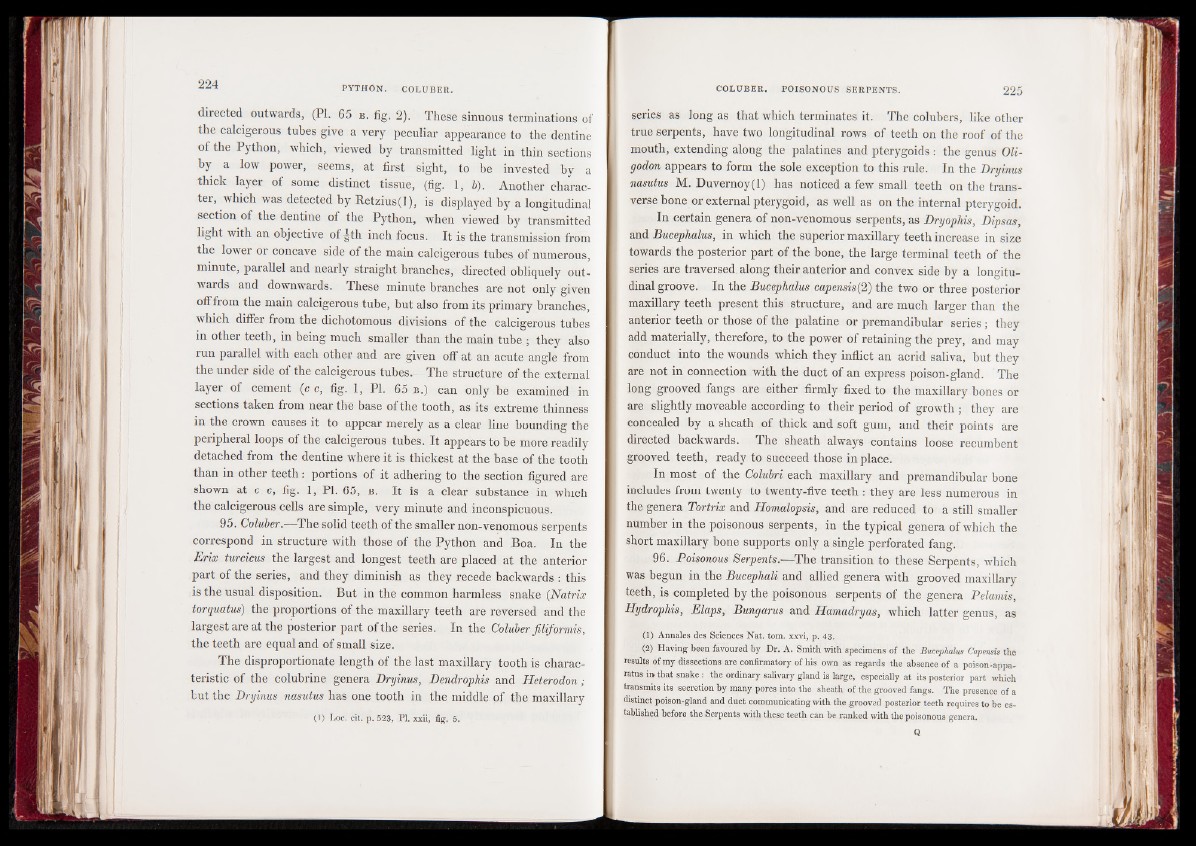
directed outwards, (PI. 65 b . fig. 2). These sinuous terminations of
the caleigerous tubes give a very peculiar appearance to the dentine
of the Python, which, viewed by transmitted light in thin sections
by a low power, seems, at first sight, to be invested bv a
thick layer of some distinct tissue, (fig. 1 , b). Another character,
which was detected by Retzius(l), is displayed by a longitudinal
section of the dentine of the Python, when viewed by transmitted
light with an objective of §th inch focus. It is the transmission from
the lower or concave side of the main caleigerous tubes of numerous,
minute, parallel and nearly straight branches, directed obliquely outwards
and downwards. These minute branches are not only given
offfrom the main caleigerous tube, but also from its primary branches,
which differ from the dichotomous divisions of the caleigerous tubes
in other teeth, in being much smaller than the main tube ; they also
run parallel with each other and are given off at an acute angle from
the under side of the caleigerous tubes.. The structure of the external
layer of cement (c c, fig. 1, PI. 65 b .) can only be examined in
sections taken from near the base of the tooth, as its extreme thinness
in the crown causes it to appear merely as a clear line bounding the
peripheral loops of the caleigerous tubes. It appears to be more readily
detached from the dentine where it is thickest at the base of the tooth
than in other teeth : portions of it adhering to the section figured are
shown at c c, fig. 1, PL 65, b . It is a clear substance in which
the caleigerous cells are simple, very minute and inconspicuous.
95. Coluber.—The solid teeth of the smaller non-venomous serpents
correspond in structure with those of the Python and Boa. In the
Erix turcicus the largest and longest teeth are placed at the anterior
part of the series, and they diminish as they recede backwards : this
is the usual disposition. But in the common harmless snake (Natrix
torquatus) the proportions of the maxillary teeth are reversed and the
largest are at the posterior part of the series. In the Coluber filiformis,
the teeth are equal and of small size.
The disproportionate length of the last maxillary tooth is characteristic
of the colubrine genera Dryinus, Dendrophis and Heterodon;
but the Dryinus nasutus has one tooth in the middle of the maxillary
Cl) Loc. cit. p. 523, PI. xxii, fig. 5.
series as long as that which terminates it. The colubers, like other
true serpents, have two longitudinal rows of teeth on the roof of the
mouth, extending along the palatines and pterygoids : the genus Oli-
godon appears to form the sole exception to this rule. In the Dryinus
nasutus M. Duvernoy(l) has noticed a few small teeth on the transverse
bone or external pterygoid, as well as on the internal pterygoid.
In certain genera of non-venomous serpents, as Dryophis, Dipsas,
and Bucephalus, in which the superior maxillary teeth increase in size
towards the posterior part of the bone, the large terminal teeth of the
series are traversed along their anterior and convex side by a longitudinal
groove. In the Bucephalus capensis(2) the two or three posterior
maxillary teeth present this structure, and are much larger than the
anterior teeth or those of the palatine or premandibular series ; they
add materially, therefore, to the power of retaining the prey, and may
conduct into the wounds which they inflict an acrid saliva, but they
are not in connection with the duct of an express poison-gland. The
long grooved fangs are either firmly fixed to the maxillary bones or
are slightly moveable according to their period of growth ; they are
concealed by a sheath of thick and soft gum, and their points are
directed backwards. The sheath always contains loose recumbent
grooved teeth, ready to succeed those in place.
In most of the Colubri each maxillary and premandibular bone
includes from twenty to twenty-five teeth ■ they are less numerous in
the genera Tortrix and Homalopsis, and are reduced to a still smaller
number in the poisonous serpents, in the typical genera of which the
short maxillary bone supports only a single perforated fang.
96. Poisonous Serpents.—The transition to these Serpents, which
was begun in the Bucephali and allied genera with grooved maxillary
teeth, is completed by the poisonous serpents of the genera Pelamis,
Hydrophis, Elaps, Bungarus and Hamadryas, which latter genus, as
(1) Annales des Sciences Nat. tom. xxvi, p. 43.
(2) Having been favoured by Dr. A. Smith with specimens of the Bucephalus Capensis the
results of my dissections are confirmatory of his own as regards the absence of a poison-apparatus
in that snake : the ordinary salivary gland is large, especially at its posterior part which
transmits its secretion by many pores into the sheath of the grooved fangs. The presence of a
distinct poison-gland and duct communicating with the grooved posterior teeth requires to be established
before the Serpents with these teeth can be ranked with the poisonous genera.
Q